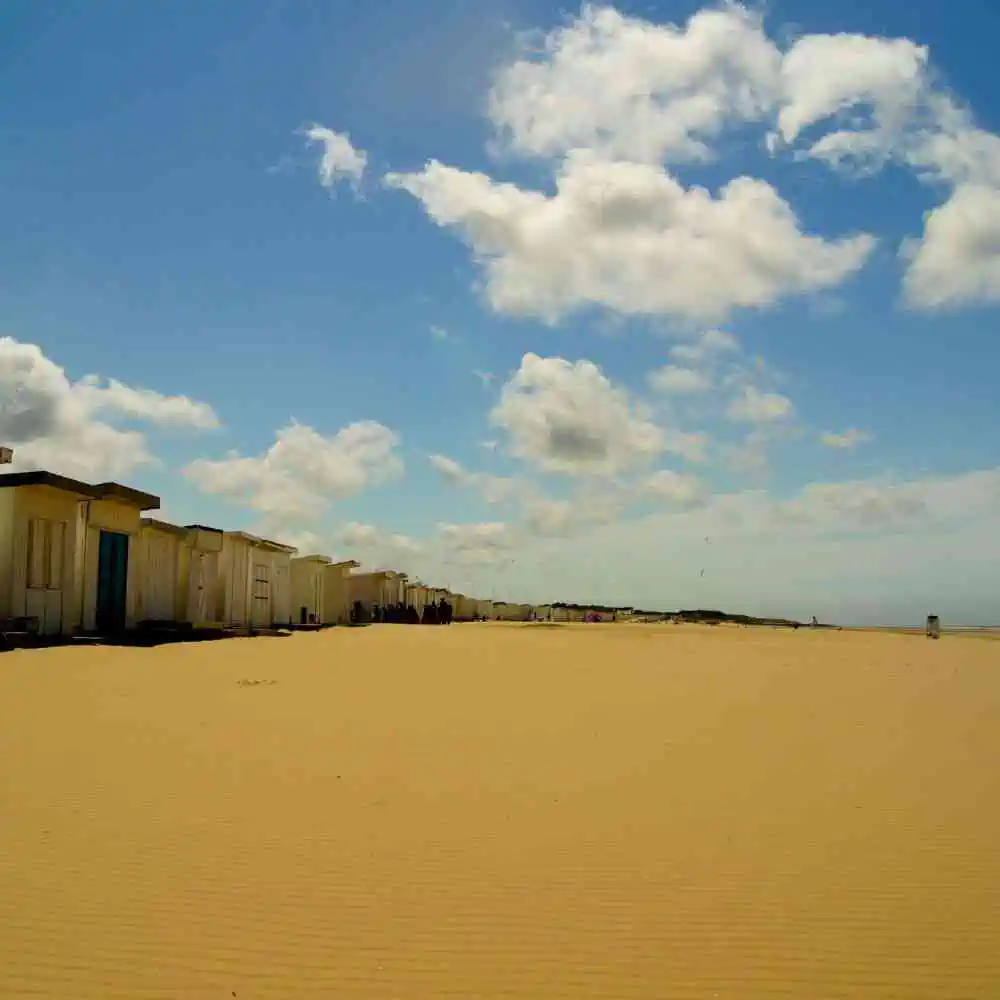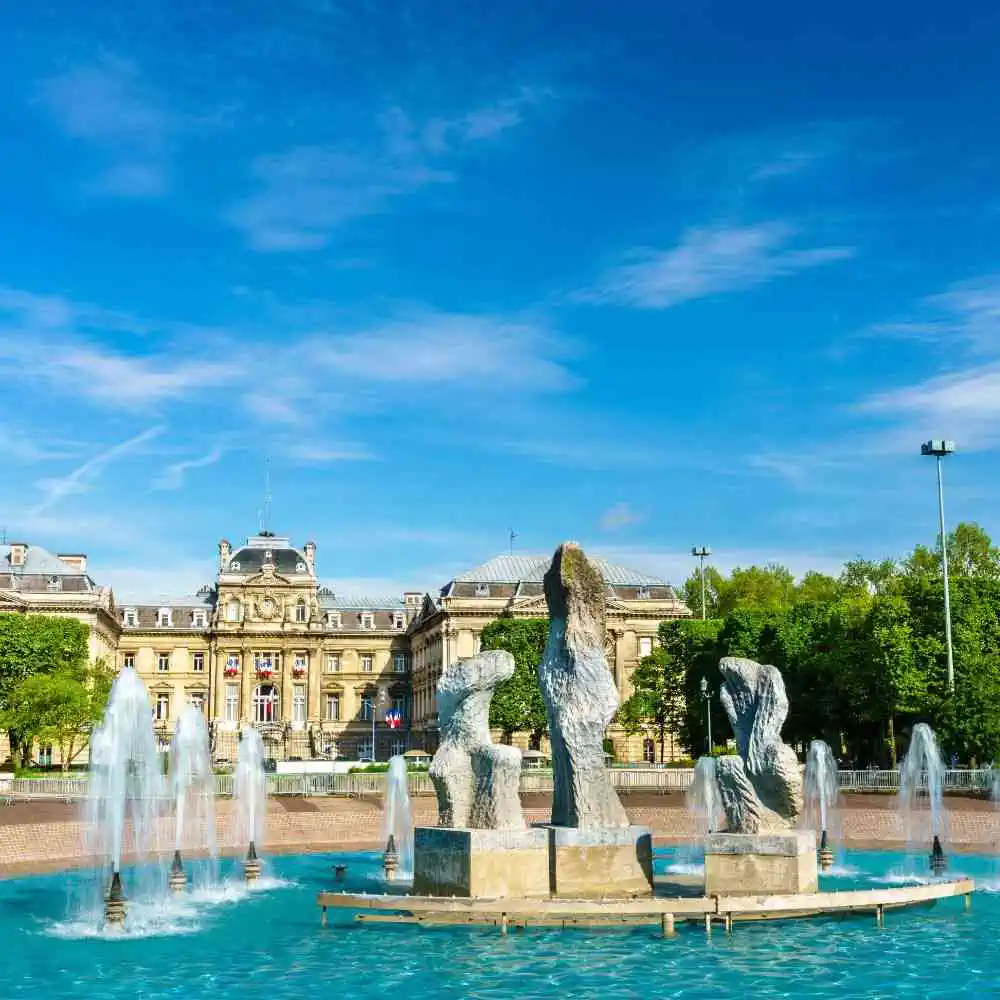Você partirá de Lille, localizado bem no centro da cidade de Lille, e desfrutará da bela paisagem da viagem enquanto chega em Calais Cidade, também localizada no coração de Calais.
Comboios de Lille para Calaisde $ 17.00
Comboios de Lille para Calais
Viajando de comboio: Lille - Calais
Traveling from Lille to Calais is a great way to roam the beautiful countryside of Northern France. Passengers can enjoy the landscape of both urban and rural villages as they make their way between the two cities. Although the trip is relatively short, there are plenty of things to do in both Lille and Calais along the way.
The train journey from Lille to Calais typically takes about an hour and a half and is approximately 80 kilometers or 50 miles. Popular stops along the way include Tourcoing, Hazebrouck, Saint-Omer, Ardres, and Fréthun. As you pass through these towns, be sure to take in the stunning views and iconic buildings such as the Fréthun Train Station and the Hazebrouck Rail bridge.
In addition to these attractions, visitors may also wish to explore the various cafes and restaurants located in the major train stops. These stops typically feature a variety of delicious local dishes, ranging from traditional French fare to a variety of international cuisines.
One of the most iconic features of traveling by rail in this part of France is the unique view of the countryside. From the windows of the train, you can observe lovely farms, pristine lakes, and lush forests along the way. This makes for an awe-inspiring journey that can be enjoyed while you relax in the comfort of a train car.
When arriving in Calais, visitors are immediately greeted by the impressive Pas-de-Calais monument. This monument is a reminder of the battles of World War I and serves as a poignant reminder of the past.
All in all, traveling from Lille to Calais by train is a great way to explore the countryside and urban areas of Northern France. With its beautiful scenery, unique attractions, and delicious eateries, this journey is sure to be both memorable and enjoyable. Bon voyage!

Detalhes da viagem
How long does the train from Lille to Calais take?
The journey from Lille to Calais by train usually takes approximately 30 minutes to 1 hour, depending on the specific service and whether changes are required.
What is the fastest journey from Lille to Calais by train?
The fastest train journey from Lille to Calais can be as short as 30 minutes on the direct services that are available.
How much does the train cost from Lille to Calais?
The cost of a train ticket from Lille to Calais can vary, but prices start from approximately €10 to €30, depending on when you book and the class of service.
How much does the Lille to Calais?
Yes, there is a direct train service from Lille to Calais, making it convenient for travelers looking for a smooth journey without the need for transfers.
What is the distance from Lille to Calais by train?
The distance from Lille to Calais by train is approximately 116 Km.
Which are the cities that the train stops from Lille to Calais?
On some services, the train may stop at various cities between Lille and Calais, including Dunkerque. However, direct services will not stop at any intermediate cities.
Compre bilhetes de trem de Lille para Calais
Viajar de trem de Lille para Calais é uma jornada fácil e confortável. RailClick é a melhor maneira de viajar pela Europa de trem.
Lille: Locais para ver
Imagine descobrir uma cidade na França onde a história e a modernidade se entrelaçam de maneira fascinante. Lille, localizada no coração da Europa, é exatamente esse lugar. Com sua rica herança cultural, arquitetura impressionante e culinária deliciosa, Lille promete uma viagem inesquecível. Vamos explorar os tesouros escondidos e os sabores que fazem desta cidade um destino imperdível!
Grand Place (Praça do General de Gaulle): O coração pulsante de Lille, cercado por fachadas de prédios históricos e o antigo prédio da bolsa de valores, a Vieille Bourse. Um ponto de encontro repleto de energia e história.
Vieille Bourse: Dividindo espaço com a Grand Place, este antigo edifício da bolsa de valores é uma obra-prima da arquitetura do século XVII, agora abrigando livrarias de segunda mão e lojas de arte.
Citadelle de Lille: Uma imponente fortaleza projetada por Vauban no século XVII. Ideal para amantes da história e para quem gosta de passear em meio à natureza.
Palais des Beaux-Arts: Um dos maiores museus da França, abrigando coleções de arte europeia que datam do século XV ao XX. Não perca as obras de Rubens e Goya.
Rue de Bethune: Esta rua de pedestres é o lugar perfeito para compras e observar a vida local. Lojas de marcas famosas lado a lado com cafés charmosos.
La Piscine - Museu de Arte e Indústria: Localizado em Roubaix, perto de Lille, este museu único é alocado em uma antiga piscina art déco, oferecendo uma experiência de museu diferente.
Wazemmes Market: Para uma autêntica experiência culinária, visite este mercado vibrante. Experimente o famoso queijo Maroilles e a tarte au sucre, típicos da região.
Viajar por Lille é como caminhar por um livro de história vivo, com cada esquina revelando uma nova página de sua rica herança. Entre passeios por monumentos históricos e degustação de especialidades locais, você encontrará em Lille a essência da França. Uma cidade que, definitivamente, merece ser explorada a pé, permitindo que você absorva completamente sua atmosfera única.

Calais: Locais para ver
Calais is the capital of Pas-de-Calais in the Hauts-de-France region of France. The city is a major port in Northern France, situated on the coast of the English Channel. Calais has a rich cultural and architectural heritage, as well as interesting gastronomy. Whether you're looking for a historical adventure or a foodie experience, Calais proves to be a great destination for a short getaway. Check out this list of must-see sites to maximize your trip to Calais.
Parc Naturel Régional des Caps et Marais d'Opale: This region is composed of both marshes and cliffs, making for a unique landscape. Explore the numerous walking paths through the nature reserve, and take a boat tour to discover the migratory birds that flock here. Entrance fee is €7.50.
Tour du Guet: This medieval watchtower is the last of its kind still standing in Calais. On a clear day you can see England from the tower. Admission is free.
The Calais Hotel de Ville: This 17th century masterpiece by architect Jean de Fouquet is a must-see. Go during the day to admire the chapel and the courtyard before heading out to explore the rest of the city.
The Calais Beffroi: This bell tower from the 13th century is a symbol of Calais. It stands more than 97 meters tall and is visible from many parts of the city. Entrance fee is €4.
Musée des Beaux-Arts et de la Dentelle: This museum will guide you through the history of Calais and its art from the Middle Ages to present day. You can also learn about the local lace-making traditions that the city is famous for. Admission is free.
La Croix-Rouge: This 19th century museum offers a great overview of the region’s history, art, and culture. Admission is €5.
Cuisine of Calais: While in Calais don’t forget to try their traditional dishes, from marinated sardines to maroilles cheese. And you can’t leave without tasting the world-famous beer, Brun Lefebvre.
In conclusion, Calais is a hidden gem for those looking for culture and history, while also offering the chance to enjoy its rich gastronomic tradition. Whether you're visiting for the day or the weekend, there are plenty of activities for every type of traveller.

Lille: Principais estações de comboio
A estação ferroviária principal de Lille, conhecida como Lille Europe, é um ponto chave para viajantes na França e na Europa. Além dela, a cidade de Lille abriga outra estação importante, a Lille Flandres, que atende principalmente comboios regionais e alguns serviços de alta velocidade. Essas estações são essenciais para quem deseja explorar a França e países vizinhos, oferecendo uma ampla gama de opções de transporte.
A Lille Europe está localizada no coração da cidade, sendo facilmente acessível para turistas e moradores. Seu endereço é 1 Place François Mitterrand, 59777 Lille, França. Esta estação opera diariamente, mas é importante verificar os horários específicos de funcionamento, pois podem variar. Para a comodidade dos viajantes, a estação oferece serviços de consignação de bagagens, permitindo que os passageiros explorem a cidade com mais liberdade e conforto.
- Lille-Europe
- Lille-Flandres
- Croix-l’Allumette
Calais: Principais estações de comboio
Calais is a city of the French department of Pas-de-Calais in northern France. The city has an important train station, Gare de Calais, that connects it with other big cities in France and other countries. There is also a smaller station, Gare de Calais-Fréthun, which is served by local services.
The address of Gare de Calais is Place d'Armes, 62100 Calais. It is open everyday from 6am to 11:30pm. The best way to find out more is to contact their information desk at 03 21 19 19 30. The station also provides luggage storage services.
- Calais Cidade
- Calais Fréthun
Lille - Calais: Como conseguir as melhores ofertas
Reserve com Antecedência:
Assim como nas passagens aéreas, os preços dos bilhetes de comboio tendem a aumentar à medida que a data de partida se aproxima. Reservar com semanas ou até meses de antecedência pode economizar uma quantia significativa.
Viaje Fora do Horário de Pico:
Evite viajar em horários de pico, como nas manhãs e noites de dias úteis. Opte por viagens ao meio-dia, no final da noite ou durante a semana, quando há menos demanda.
Considere comboios mais lentos ou rotas não diretas:
Os comboios expressos ou de alta velocidade podem economizar tempo, mas geralmente são mais caros. Optar por serviços regionais ou mais lentos pode reduzir sua tarifa.
Procure por Ofertas Especiais e Promoções:
Os operadores de comboios ocasionalmente têm promoções ou ofertas especiais, especialmente durante a temporada de baixa demanda. Vale a pena se inscrever para receber newsletters. Além disso, às vezes existem descontos para grupos ou para bilhetes de ida e volta, então considere essas opções se elas se encaixarem em seus planos de viagem.
- Contacte-nos


